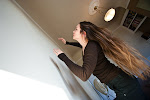To Gia Kourlas, writer of “Time to put choreography back on its feet”
In the New York Times on Sunday, Sept 5 2010
Thank you to Gia Kourlas for writing an article about what is going on in the contemporary, or experimental, dance. Media takes up this area of creativity very rarely, editors choosing more conservative, classical, or commercial dance to focus on.
A choreographer and dancer, I live and work in the middle of the change in western contemporary dance. It is a pleasure to read weighed words about that slowly churning, but intense, tumult from outside the circle of colleagues. For the art form it is important to have a record of the dialogue in and about it.
There is another deep running change going on in the dance world that Gia Kourlas didn’t mention in their article.
Both in Europe and in North America contemporary western dance is evolving, and dancers’ professional skills are a part of it, whichever way the causality may run. G. Kourlas gives the impression that one reason why new dance pieces “contain so little dance”, is that dancers can’t afford expensive technique classes, or choose yoga or pilates instead, and are thus less skilled than they should be.
Since I see fabulous movers, even virtuosic dancers around me, I was prompted to comment on this idea.
While what Gia Kourlas writes might sometimes be true, there are other reasons for skipping the traditional dance class. Dance technique, as it is taught today, is often dated. In many cases these techniques don’t prepare for the demands of experimenting with movement. Surely the aesthetics of most modern techniques and ballet doesn’t agree with many young and mid-career choreographers. Good, or any, contemporary technique classes might be difficult to find.
Even more pressingly, traditional technique classes are based on dated perceptions about anatomy and kinesiology. Dancers learn from their injuries and gravitate towards training that promises healing and maintenance, along with strength, stamina and flexibility - be it mental or physical.
Like Gia Kourlas writes, we do indeed live exciting times, there is promise in the air, and dance artists are breathing deeply. There are teachers, kinesiologists and dancers that are developing systems of teaching and training that support healthy movement. These dedicated people can be found in different dance disciplines.
I am hopeful that dance training is in the middle of a change of paradigm, slowly but surely. I feel fortunate to live these times, especially because I harbor a love and appreciation for deep rooted traditions, too, ballet most of all.
This development in technique is a very natural thing as sports and dance medicine are both evolving. A related example is the breakthrough in how we perceive running, and how more and more people are starting to run more naturally.
An ongoing evolution, rather than lesser dancers, is the status quo of contemporary dance. And I spy a lot of joy in movement when I work with my colleagues, or when I see their creative output.
Truly yours,
Minna Harri
Choreographer and dancer
San Francisco, USA and Helsinki, Finland



No comments:
Post a Comment